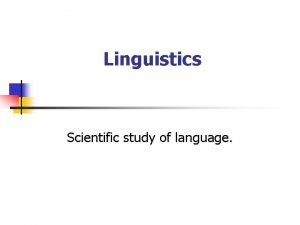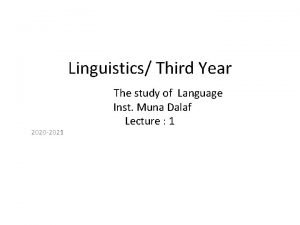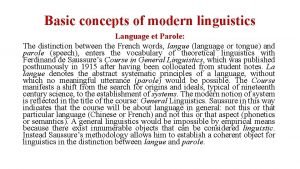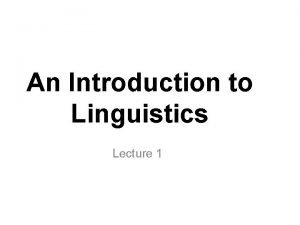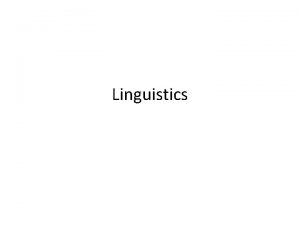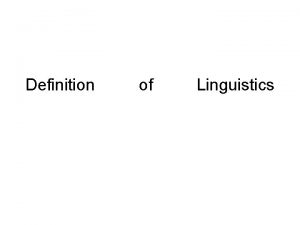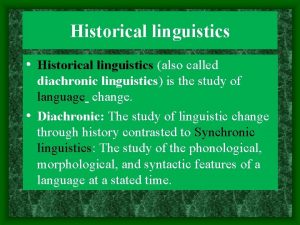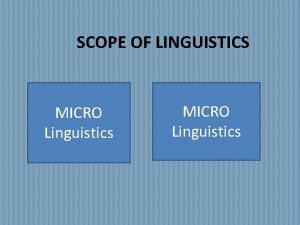2 WHAT IS LANGUAGE Linguistics the scientific study










- Slides: 10

2 - WHAT IS LANGUAGE? Linguistics: the scientific study of LANGUAGE. Language is: the specialized sound signalling system which seems to be genetically programmed to develop in humans.

The design features of language (Charles Hockett) 1. Use of Sound Signals: Q 1: Is this a unique feature? (humans, grasshoppers, birds, dolphins, cows, monkeys and many other species) Q 2: What some other ways used by animals? (bees, crabs…. ) • Advantages of sound signals: 1. they can be used in the dark and at some distance 2. they allow a wide variety of messages to be sent 3. they leave the body free for other activities. Q 3: Were the organs of speech originally created for speaking? 1. yes 2. no, adapted

The design features of language (Charles Hockett) 2. Arbitrariness: - There is no link between the signal and message (form & meaning) book - There is a recognizable link between the sound and its meaning that an animal wishes to convey. ( warning, fear, hunger, pain) v Onomatopoeic Words (Echoism) (bomb, quack-quack, whistle)

The design features of language (Charles Hockett) 3. The need for learning: (culturally transmission) 1. A new-born child has a innate predisposition towards language learning. This ability can be activated only by long exposure to language. 2. Human Languages are learned in social groups. v Animal communication systems are usually transferred genetically, i. e. no need for learning from others. (bee !!)

The design features of language (Charles Hockett) 4. Duality: • Language is organized into two layers (strata or levels): 1. the primary level consists of the basic single sounds (phonemes) which are meaningless (f, g, d, o) 2. the secondary level consists of the combination of these phonemes in various ways to produce meaningful elements. (fog, god, dog, doff) § Animals who use vocal signals have the first level only.

The design features of language (Charles Hockett) 5. Displacement: A unique and positive design feature of language a. time ( past, now, future) vs (now only) b. place (close, remote, imaginary) c. subject ( unlimited ) vs vs (close only) (here) ( very limited)

The design features of language (Charles Hockett) 6. Creativity : (Productivity) The human infant can produce and understand novel utterances in different situations.

The design features of language (Charles Hockett) 7. Patterning: The sounds of a word and the words of a sentence arranged according to certain patterns. e. g. 1. In English the sounds (a, b, s, t) could be arranged in only four patterns: (bats, tabs, stab, bast) while sequences such as (*sbat, *abts, *stba) are not existed. e. g. 2. To form a sentence from the words (burglar, loudly, sneezed, the) only three patterns (combinations) are possible. 1. 2. 3. 4. 5. The burglar sneezed loudly. Loudly the burglar sneezed. The burglar loudly sneezed. *The loudly burglar sneezed. *Sneezed burglar loudly the. (well-formed) (ill-formed)

The design features of language (Charles Hockett) 8. Structure dependence: is another feature of language that differs from AC. 1. Sentences have internal structures The English teacher arrived. 2. Each sentence consists of a number of basic elements 1. S + V 2. S + V + O 3. S + BE + Adj 3. The elements have rather fixed positions 4. The elements of a structure may consist of one word or more, more and even can be omitted 5. For certain purposes, the elements can change places a. The patient must eat vitamins. b. Must the patient eat vitamins?

• Language is a patterned system of arbitrary sound signals characterized by structure dependence, creativity, displacement, duality and cultural transmission.
 Language
Language Traditional linguistics and modern linguistics
Traditional linguistics and modern linguistics Applied linguistics history
Applied linguistics history By the year 2020 linguists
By the year 2020 linguists Information gathered during an experiment
Information gathered during an experiment How is a scientific law different from a scientific theory?
How is a scientific law different from a scientific theory? Parole und langue
Parole und langue Langue definition in linguistics
Langue definition in linguistics Signing naturally homework 2.9 names and tidbits
Signing naturally homework 2.9 names and tidbits Language and the brain in linguistics
Language and the brain in linguistics Social psychology is the scientific study of:
Social psychology is the scientific study of:
